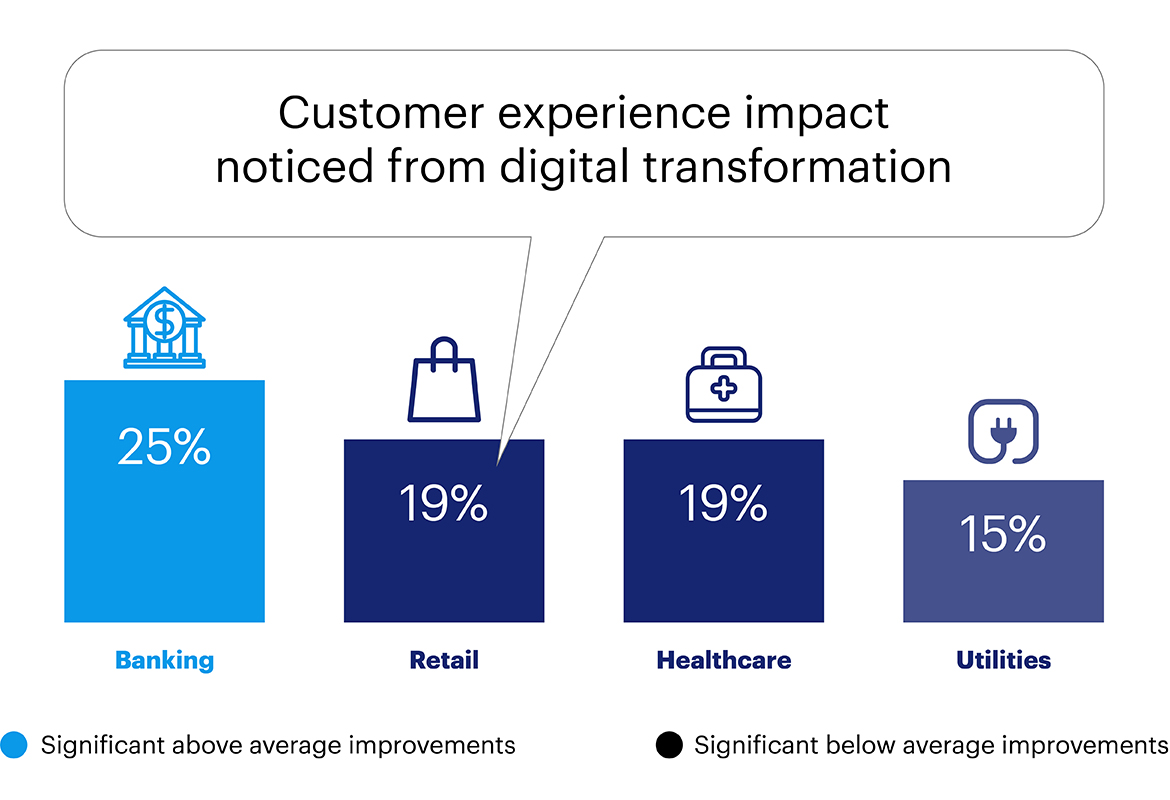The continuous development and increase in the number & quality of commercial banks makes the financial and banking services market more fierce than ever. Faced with these many challenges, service providers in the industry must always grasp new trends to meet the ever-increasing needs of customers.
Along with the wave of digital transformation, banks are also constantly transforming themselves by changing their business thinking, restructuring their organizations, forming business departments, technology centers, and in particular, focusing on the core factor that actually makes a difference: Focus on improving the customer experience.
Some of the statistics on customer experience have provided the following results (1):
- 69% of customers want to leave their current bank because of poor customer service.
- 56% of customers who are leaving said their bank made no effort to engage them.
- 80% of today’s customers consider their experience with a company to be just as important as the product it offers.
- 69% of respondents expect to communicate with service providers in a real-time manner and direct way.

This shows that customers are increasingly looking forward to and placing more expectations on breakthrough changes that make the most convenient, easy and cohesive experiences possible. The question is, how can banks meet these expectations and ensure that all customer journeys go smoothly? One of the most intuitive methods used today to understand and upgrade the customer experience is to learn about the customer journey.
Methods of building customer journeys
A customer journey includes a collection of customer experiences with a business or brand. Building the right customer journey helps businesses understand customers, find problems that arise during interaction with the brand, thereby upgrading the experience at these points of interaction to make them smooth and consistent. The customer experience journey in the banking sector, more specifically, is determined from the initial interaction as the user tries to learn about the products that the bank offers, and whether the communication channels are suitable, the registration, getting familiar, actual usage and gradually become more connected, then go on to use other services that the bank offers.
According to Salesforce, on average, each customer uses 10 channels to communicate with companies, prioritizing 6 channels out of them 3. To create a perfect and continuous experience journey, businesses must embark on building a customer journey map – a visual presentation that helps tell the story of the customer experience with the business at every touch point on channels from offline to online: email, social network, livechat, support switchboard, representative store,… More specifically, with the variety of services that banks provide and the level of digitization of service delivery channels, the number of customer experience journeys is also more and more diverse.
1. Customer segmentation classification
- Categorized by customer group include: institutional customers (large, small and medium-sized business customers) and individual customers.
- Categorize by the type of service we provide, e.g., savings, investments, cards, insurance, and other extended services.
With a large number of system experience journeys, one of the most important factors to be able to continue to improve the process of optimizing customer experience is the specification of business strategy, identifying the target customer audience, the type of core service based on the actual analysis of the business situation, market and competition, in order to identify the group of journeys to experience the goal that the bank needs to focus on perfecting, then build the journey details and step by step find out the issues to improve, in order to build the trust from groups of loyal customers.
2. Build customer portraits
Build customer portraits (customer profiles) through business data, online, offline, preliminary and in-depth interview methods, to understand their psychology, actions, desires in a financial service, banking, and the problems customers encounter while experiencing these services. Then separate them into groups of customers to find the target customer portrait.
3. Identify touchpoints
Identify touchpoints that arise in customer-to-bank interactions. Touch points are one of the most important factors that make up the customer journey, which helps to detect unresolved problems between customers and businesses.
4. Build a customer journey map
Choose the right type of cruise map depending on the purpose of use for construction. Customer journey maps may include recording a user’s actions, thoughts, and feelings when performing an action at each touchpoint, or recording customer experiences in stages, and may contain department information related to the process of interacting directly with the customer.

The benefits of building a Customer Journey
Building a successful customer journey will help the bank answer important questions related to delivery services, from understanding customers, identifying problems to predicting future service innovations.
1. Identify your customers
The focus of delivering perfect, customer-centric services is gaining insights into customers’ wants and expectations when experiencing and using services at the bank. Through the process of building an experience journey, the bank will get answers to the questions: who are their customers, what do they want and feel, how they interact with the bank’s systems, what hinders customers’ frustration, and what to do to solve those problems.
2. Bringing advanced experiences to customers
The trend of developing digital banks is bringing up entirely new experiences to customers, especially banking services for a new generation of customers, modern, young, dynamic, who put experience first and have a desire for personalization and the conveniences of financial management. The customer journey helps to capture all the research on the new customer experience, to minimize assumptions for the new service development process, and to answer users’ questions about the experiences and comparing each one, to fill in the gaps that help customers easily adapt during the digital transformation process.
3. Build trust with customers
This is the point of reducing the difference between banks with a long tradition and long-established trust compared to commercial banks with a new established lifespan entering a local market. Building an experience journey that helps figure out the customer’s emotional journey when interacting with a service can help identify moments when a customer’s trust is compromised or the service delivery is not as expected. By integrating smart features and touchpoints into the customer journey, personalized relationships can take shape, giving customers a more secured experience, and willing to put their trust in where their assets are managed.
The story of improving customer service at DBS, the world’s leading bank
DBS is Asia’s leading financial services group with a presence in 18 global markets. In 2016, following the launch of a digital bank in India, DBS noted an error that occurred that a customer had triggered an extremely high number of transactions in a very short period of time causing the app to fail. This raised a question for the managers as to why can’t they identify this flaw before it happens and even until after the 100th transaction. From this question, the team at DBS has begun to make important decisions in tracking the customer’s journey to recognize the signs of abnormalities in the interaction with the system and promptly support when the customer is having difficulty with the mobile application. The efforts of DBS Digital Bank’s customer journey data analysis have rapidly improved its capabilities and value by significantly minimizing unnecessary calls to customer care centers, due to minimizing errors that arise during customers’ experiences. These activities kick off the process of continuous customer service improvement with optimizing the experience at touchpoints through the continuous application of new technologies: voice biometrics, chatbots and data analysis technology for communication centers. This reduces the number of future support calls by up to 20% over the next 3 years and also gives DBS a series of impressive awards in the field of customer experience enhancement, which was named “World’s Best Bank” by Euromoney, “Global Bank of the Year” by The Banker and “World’s Best Bank” by Global Finance (3) (4).
In conclusion, enhancing customer experience is one of the top trends that retail banks cannot overlook. In particular, outlining customer journeys that are most realistic, in order to overcome problems in a timely manner will help banks significantly increase the gap between them and their competitors.
Reference sources:
(1) Salesforce. 2018 State of the Connected Customer
(2) Revechat. 2021 8 Trends Transforming Digital Customer Experience in Banking
(3) SBR. 2020 DBS enhances customer service touchpoints
(4) Forbes. 2021 The Future Of Work Now: Customer Science At DBS Bank



